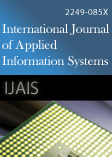
- Vipin Kumar and Ankit Verma and Shashank Bharadwaj 2012. Complementary Perfect Domination Number of Regular Graphs. International Journal of Applied Information Systems. 4, 2 (September 2012), 12-16. DOI=http://dx.doi.org/10.5120/ijais450615
-
@article{10.5120/ijais2017451568, author = {Vipin Kumar and Ankit Verma and Shashank Bharadwaj}, title = {Complementary Perfect Domination Number of Regular Graphs}, journal = {International Journal of Applied Information Systems}, issue_date = {September 2012}, volume = {4}, number = {}, month = {September}, year = {2012}, issn = {}, pages = {12-16}, numpages = {}, url = {/archives/volume4/number2/271-0615}, doi = { 10.5120/ijais12-450615}, publisher = { xA9 2010 by IJAIS Journal}, address = {} } -
%1 450615 %A Vipin Kumar %A Ankit Verma %A Shashank Bharadwaj %T Complementary Perfect Domination Number of Regular Graphs %J International Journal of Applied Information Systems %@ %V 4 %N %P 12-16 %D 2012 %I xA9 2010 by IJAIS Journal
Abstract
In this paper authors describe domination number of regular graphs as well as complimentary perfect domination number and induced complimentary perfect domination number, denoted by cpd and iced. Let G(v,e) be a graph with 'n' vertices and 'e' edges then these are denoted by . and . In this paper we describe, How to calculate . and of regular graphs. Authors characterize 2 regular graphs with and 3 regular graphs with and describe an upper limit for number of vertices in d-regular graph. In the end of the paper we characterize all the d-regular graphs with and practical utilization of cpd and ipcd.
References
- Arumugam S, "Total Domination graph " Arts Combing – 43 (2008) P. P / 89-92
- Paulraj Joseph, J and Arumugam S "Domination and connectivity in graphs. IJOMAS V-3 (1992) P. P 233-236
- Paulraj Joseph, J and Arumugam S "On graph with equal domination and connected domination number. " Disc Math's 206 (1999)(45-49)
- Sampat Kumar, E Walikar, "The connected Domination number of a graph J. Math Physics science-13 (1979) No-6 P. P 607-613
- Teresa W, Hayes and Peter J. Slater Fundamentals of domination in Graph Journal of G. T. 07 1998
- Balakrishan R and Reganathan K, A textbook of Graph Theory, Springer Verlog, New York.
- Haynes, Teresa W, "Induced – Paired Domination n Graphs" Arts Combing 57 P. P (111-128)
- Salter, P. J "Domination and Reference set in a graph, J. Math Physicd Science" 22 (1998) P. P (455-465)
- W, maccuaig and B shepherd," Domination in graph with minimum degree two" Journal of graph Theory 13 (1989) (749-762).
- P,Manual,I Raja Singh J Quadras "Embedding of hypercube in to complete binary tree" ICICS,Iternational Conference, Saudi Arabia. (2000).
- Paulraj J Joseph and Mehadevan,"Induced and -paired domination chromatic number of a graph" Journal of Discrete Mathematics & Cryptology. (Reprint)
Keywords
Domination number, representation of two graphs with one, cpd and ipcd of regular graph, d-regular
 10.5120/ijais12-450615
10.5120/ijais12-450615
